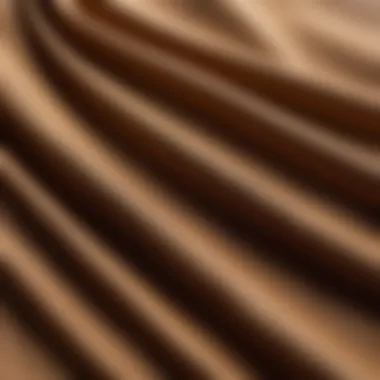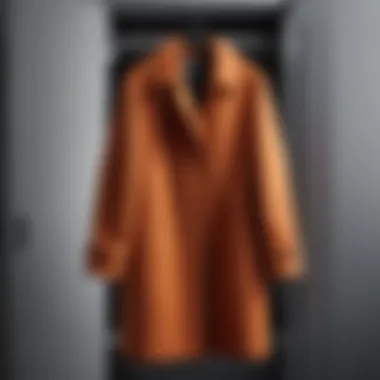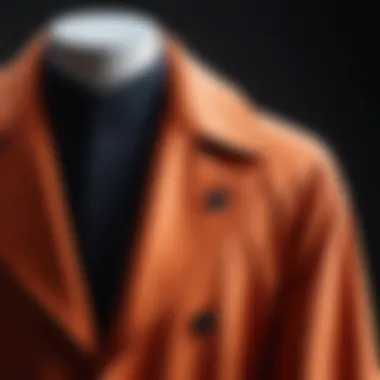Exploring the Importance of Coat Covers in Everyday Life


Intro
Актуальные акции и скидки
Обзор текущих предложений
The market for coat covers is quite diverse, with various retailers offering seasonal discounts. Brands like The Container Store and Storage Solutions frequently have promotions that allow customers to purchase quality coat covers at lower prices. Keeping up with these offers can save considerable money.
Специальные предложения от популярных брендов
Major retailers like Barnes & Noble and Macy's often provide special deals, especially around holidays. Signing up for newsletters can ensure that potential buyers receive timely updates on these promotions.
Practical Importance
The practical importance of coat covers cannot be understated. They serve primarily to protect garments from environmental factors. A coat cover can keep dust and dirt at bay, ensuring that outerwear maintains its cleanliness. Furthermore, moisture is another enemy of clothing, especially in damp conditions. A waterproof or water-resistant cover can be beneficial in these environments.
Another aspect is the organization they provide. Neatly stored coats ensure easy access and less hassle when dressing. A well-organized closet space is fundamental for efficient living, especially for families with children. Finding the right cover can streamline this process.
Aesthetic Importance
Coat covers also play a role in the visual appeal of a wardrobe. An assortment of attractive covers can enhance the overall look of a closet. Fabrics come in numerous designs and colors. Consumers have the option to choose covers that complement their interior design. This choice adds a personal touch to home decor, while still serving a functional role.
Material Qualities
Different materials offer various advantages. Covers made from breathable fabrics, like cotton blends, ensure air circulation, preventing musty smells. On the other hand, synthetic options made from polyester or nylon may provide extra durability and resistance to stains. When selecting materials, consider usage context, as certain fabrics may be better suited for specific environments.
Use Cases
The versatility of coat covers extends beyond simple storage. They can be used during travel, providing protection in luggage. Many people employ coat covers as dust shields when hung in closets. Different uses highlight their flexibility.
Maintenance Requirements
Maintaining coat covers is essential for their longevity. Regular washing, following the manufacturers' instructions, can keep them looking new. Some materials may be machine washable, while others require dry cleaning. Understanding these requirements can prolong the life of the coat cover itself.
Economic Advantages
Investing in a coat cover can offer economic benefits. Protecting outerwear minimizes the need for repairs caused by environmental damage. Preventing such wear can save money in the long run. Moreover, a well-preserved coat retains its value over time, beneficial for those considering resale in the future.
Epilogue
Prelims to the Coat Cover
A coat cover holds substantial significance in today's fashion landscape, serving both practical and aesthetic purposes. As a protective garment accessory, it not only safeguards coats from various environmental factors but also ensures the longevity of these investment pieces. Understanding what a coat cover is and the reasons for its creation allows consumers to appreciate its role in garment care.
Definition and Purpose
A coat cover is a protective sheath designed to encase a coat, preventing damage but allowing it to breathe. Its primary purpose is to shield coats from dust, moisture, and potential wear during storage or transport. Many jackets, especially expensive or delicate fabrics, require the extra care offered by a coat cover to maintain their original quality. By utilizing a coat cover, coat owners can effectively preserve their clothing while enhancing the organization of their storage spaces. Additionally, these covers often come with various features to accommodate different needs and preferences.
Historical Context
The concept of protective garment coverings has been around for centuries. Historically, coat covers were crafted from various materials, serving the dual purpose of maintenance and presentation. For instance, during the 19th century, wealthy individuals used tailored garment bags to protect their fineries from dust and damage, indicating social status as much as taste in fashion.
Over time, advancements in textile technology have introduced more sophisticated and functional materials, allowing for a broader evolution in designs and uses. Today, coat covers are widely accessible and have become an essential part of garment care practices, emphasizing the importance of both function and aesthetics in clothing preservation. These developments reflect a growing understanding of fashion-related investments and the need to prolong their lifecycle through proper care.
The shift in how coats are treated demonstrates a larger trend towards valuing sustainability and responsible consumption in fashion.


Understanding Material Types
Understanding the types of materials used in coat covers is crucial for selecting the right option. The material affects the durability, protection level, and overall functionality of the coat cover. With diverse choices available, recognizing their properties allows consumers to make informed decisions. This part elaborates on common fabric choices and important environmental considerations.
Fabric Choices
Polyester
Polyester is a synthetic material known for its resilience and unique properties. Its key characteristic is the ability to resist wrinkles and maintain shape. This makes polyester a popular choice among coat covers. The fabric is lightweight yet durable, ensuring that it does not easily tear or wear out. One unique feature is its moisture-wicking capabilities, which can help in preventing mold growth on stored garments. While polyester offers numerous advantages, it may not be as breathable as natural fibers.
Canvas
Canvas is a sturdy fabric known for its durability and robustness. Its key characteristic is its thickness, making it difficult for pests, dust, and moisture to penetrate. This is why canvas is often seen as a beneficial choice for coat covers, especially for long-term storage. One unique feature of canvas is its ability to withstand various climates without losing its structural integrity. However, despite its durability, canvas can be heavier than other materials, which may be a consideration for some users.
Non-woven material
Non-woven material is a synthetic option that has gained popularity in coat covers. Its specific aspect is the construction method, which involves bonding fibers together rather than weaving them. This gives it a unique softness while still providing durable protection. Non-woven materials are lightweight and often come at a more affordable price point. The advantages include excellent breathability, preventing moisture buildup inside the cover. One minor disadvantage is that these materials may not be as durable as polyester or canvas under constant use—but they are still effective for occasional usage.
Environmental Considerations
When selecting a coat cover, environmental factors also play a role. Many consumers today are conscious about their carbon footprint. Thus, choosing materials that are recyclable or sustainably sourced becomes essential. It is advisable to look for certifications that indicate eco-friendly practices.
- For instance, some polyester fabrics are made from recycled plastics, minimizing waste.
- Canvas can be sourced from organic cotton, reducing the impact on agriculture.
- Non-woven materials often utilize less energy in manufacturing compared to traditional woven fabrics.
Being knowledgeable about these aspects not only allows for better choices but also encourages manufacturers to adopt sustainable practices.
Design Variations
The design of a coat cover is not only about aesthetic appeal, but also about functionality. Each variant has its own distinct advantages and purpose, making it essential for consumers to grasp the available options. This section elaborates on various design features that make coat covers valuable and effective in different contexts. By understanding these variations, users can choose a coat cover that best fits their needs.
Standard vs. Tailored Fits
In the realm of coat covers, fit matters significantly. Standard fits are moreCommon and generally accommodate a variety of coat sizes. They often feature a loose design, making them easy to slip on and off. This can be a practical choice for family use, as one size may fit various garments. However, they may lack a snug fit, allowing dust and moisture to penetrate around the edges.
On the other hand, tailored fits offer a more precise solution. They contour to the specific shape of the coat, minimizing space and potential exposure to harmful elements. These covers often provide a more secure fit, making them ideal for long-term storage or travel. Users seeking to preserve valuable coats should consider tailored options for better protection.
Color and Pattern Options
A wide range of colors and patterns in coat covers adds a layer of personalization. While function is important, buyers often look for designs that resonate with their style. Bright colors or unique patterns can enhance decor when coat covers are displayed, while neutral colors blend seamlessly into any environment.
Moreover, pattern choices can inform users about the purpose of the cover. For example, a sleek, monochromatic design might suggest professional use, while playful prints could be aimed at families with children. This variety allows consumers to select covers that reflect their individual tastes or the setting in which the cover will be used.
Innovative Features
Innovative designs in coat covers can greatly improve user experience. Some advancements make coat covers easier to use and enhance their protective capabilities.
Built-in pockets
Built-in pockets provide added convenience. They allow users to store essentials such as gloves and scarves within reach. This unique feature caters to those who are always on the go. When traveling, having quick access to needed items can save time and effort.
While the addition of pockets is a popular choice, one must consider its impact on the coat cover's fit and form. If designed well, the pockets can seamlessly blend into the overall aesthetics without adding bulk. However, if poorly placed, they can interfere with the coat’s silhouette.
Water-resistant layers
Water-resistant layers represent another innovative feature that enhances protection. These layers shield the coat from moisture, a common concern for many. The ability of a coat cover to repel water means the garment underneath is safer from damage caused by condensation or accidental spills.
The practical benefits of water-resistant layers cannot be overlooked. These layers ensure that a coat remains dry during unexpected weather changes. However, it is crucial to note that breathability might be compromised. Certain materials may not allow airflow, which could lead to mildew growth if the coat cover is used for long storage.


In summary, the design variations in coat covers play a significant role in their overall utility. By understanding the differences in fits, colors, patterns, and innovative features like built-in pockets and water-resistant layers, users can make informed decisions that enhance their coat protection. This section provides critical insight into how these design considerations affect functionality and user satisfaction.
Functionality and Use Cases
The functionality and use cases of a coat cover are central to understanding its significance in everyday life. A coat cover does not merely serve as a protective layer; it plays a crucial role in extending the life of outerwear. Proper storage of garments can enhance their longevity and maintain their original condition. The diverse benefits it provides make it an essential item for anyone looking to preserve the integrity of their coats and jackets.
Protecting Against Dust and Mold
One of the primary functions of a coat cover is to shield garments from dust and mold. These elements can accumulate over time, especially in closed or damp spaces. Dust particles can settle on clothing, leading to discoloration and a dull appearance. Mold, on the other hand, thrives in moisture-rich environments. It can create unsightly stains and foul odors that are hard to remove.
Using a coat cover acts as a barrier against these contaminants. The fabric used in many coat covers is designed to be breathable, allowing air circulation while blocking out larger dust particles and preventing moisture buildup. This is particularly important for individuals who live in humid climates or who do not use their coats often. By keeping a coat covered, the likelihood of mold growth decreases significantly.
Seasonal Storage Solutions
Seasonal changes often require different garments to be stored for long periods. The coat cover offers a practical solution for seasonal storage, keeping jackets and coats neatly organized and protected. For families with children, this becomes even more critical as the frequency of outgrown clothing can increase.
Understanding the right way to store coats is vital. Here are a few important points to keep in mind:
- Clean Before Storing: Always clean coats before putting them away for a season. Dirt and oils can set into the fabric, resulting in stains that can be difficult to remove.
- Use Appropriate Covers: Select coat covers that fit the specific sizes of garments. Oversized covers can allow dust to enter, while undersized versions can lead to fabric stress and damage.
- Choose a Dry Location: Ensure the storage area is dry and well-ventilated to prevent moisture from compromising the fabric.
Seasonal storage with coat covers not only keeps garments clean but also ensures they remain ready to wear when needed again.
Travel and Transportation
When traveling, transporting coats and jackets can be a hassle. The risk of damage from other luggage or environmental factors increases. A coat cover resolves these issues by providing a dedicated space for outerwear during transit.
Using a coat cover for travel has several advantages:
- Protection from Wrinkles: Many coat covers are designed to minimize creases. This means jackets can arrive at the destination looking fresh and presentable.
- Easy Identification: A coat cover can help distinguish your outerwear from others’ while navigating through crowded areas like airports or train stations.
- Convenient Storage: Coat covers often have handles or attachment points, making them easier to carry or attach to other luggage.
By providing these functionalities during travel, coat covers play an essential role in ensuring that garments remain in optimal condition, thus offering peace of mind for those on the move.
Proper care and storage of your coat can result in significant savings by prolonging its life and preventing expensive replacements.
Maintenance and Care
Proper maintenance and care of a coat cover is essential for extending its lifespan and ensuring that it performs its function effectively. A coat cover is often the first line of defense against environmental factors that can harm valuable garments. When coats are well-maintained, they are less likely to suffer from damage due to dust, moisture, or mold. Furthermore, establishing a regular cleaning routine can prevent long-term wear and tear, resulting in cost savings by reducing the need for frequent replacements or professional cleaning services.
Cleaning Guidelines
Hand wash vs. machine wash
When it comes to cleaning a coat cover, the choice between hand wash and machine wash is critical. Hand washing is generally gentler on the fabric, preserving its structure and integrity. This method allows for a more careful cleaning process, particularly for delicate materials such as silk or fine polyester. It’s a popular choice for those who aim to maintain the quality of their coat covers while effectively removing dirt.
On the other hand, machine washing offers convenience and efficiency. Many people opt for this method due to its time-saving properties, as it often provides a thorough cleaning with less effort. Most modern washing machines have settings specifically designed for delicate fabrics, making it possible to wash coat covers without causing damage.
Drying techniques
The way a coat cover is dried can drastically affect its longevity. Air drying is the most recommended technique. It preserves the fabric and maintain the shape of the cover, avoiding the thermal damage that can occur from tumble drying. This method is gentle and allows for natural evaporation of moisture, which is especially important for fabrics that can shrink or warp.
Alternatively, if using a dryer is necessary, opting for a low heat setting can mitigate damage. However, this process still carries the risk of changes in the fabric’s texture or fit. Ultimately, the choice of drying method should reflect the material of the cover and the degree of ongoing use expected.
Storage Best Practices
Storing coat covers properly is vital for maintaining their condition. It's essential to keep them in a cool and dry environment to avoid moisture build-up, which can lead to mold or mildew growth. Optimal storage includes using breathable garment bags instead of plastic covers, which can trap humidity.
Additionally, coat covers should be placed in a position that allows for air circulation. Avoid overcrowding in storage areas, as this can lead to creases or damage to the fabric. Regularly checking stored items also helps to ensure that they remain in good shape.


Taking time to care for and maintain coat covers not only preserves their appearance but also serves to protect the investments made in the garments themselves.
Market Options and Pricing
Understanding the market options and pricing for coat covers is essential for consumers seeking to protect their garments effectively. The availability of different options allows buyers to select products that not only meet their functional requirements but also align with their budget. Prices vary based on factors like material quality, design features, and brand reputation. Knowing these can lead to informed purchasing choices that maximize value and performance.
Retail Overview
Online retailers
Online retailers have become a significant channel for purchasing coat covers in recent years. The convenience of shopping from home is a major characteristic that attracts consumers. Websites such as Amazon provide a wide variety of choices, often at competitive prices. These platforms can offer numerous customer reviews, which aids potential buyers in making informed decisions.
A unique feature of online shopping is the ability to filter results based on specific needs, such as size, material, or price range. This flexibility can benefit the consumer by allowing them to find exactly what they are looking for without the hassle of physical store navigation. However, disadvantages may include the inability to physically examine the product before purchasing and potential shipping delays.
Physical stores
Physical stores offer a tangential yet valuable avenue for purchasing coat covers. One key characteristic is the advantage of immediate access to products. Buyers can physically assess the materials, sizes, and design variations before deciding. This immediacy can enhance customer satisfaction as purchases can be made and used without waiting for delivery.
A distinct feature of physical stores is the opportunity for personal consultation. Sales staff can provide insights or recommendations that are tailored to individual needs. However, the downside might be limited stock compared to online platforms, as they may not display the full range of available options due to space constraints.
Comparative Pricing Analysis
In today’s market, price comparison is crucial when selecting a coat cover. It helps consumers find the best deal while ensuring quality. Prices usually fluctuate based on various elements:
- Material Quality: High-quality materials, such as breathable fabrics, often command higher prices, but provide long-lasting benefits.
- Unique Features: Additional functionalities, like built-in pockets or water-resistant properties, can impact the price.
- Brand Reputation: Established brands often charge more due to perceived quality and reliability.
Overall, a thorough pricing analysis can aid consumers in finding coat covers that fit their budget without compromising quality.
Economic Advantages of Using a Coat Cover
Understanding the economic advantages of using a coat cover is essential for anyone looking to protect their investment in clothing while also enhancing its longevity. A coat is often more than just a piece of apparel; it is an investment that deserves proper care. By utilizing a coat cover, consumers can save money in the long run through various means, particularly in garment longevity and cleaning costs.
Longevity of the Garment
One of the primary economic benefits of a coat cover is the extended lifespan it provides to garments. Proper storage helps prevent dust accumulation, mold growth, and potential damage from environmental factors. When a coat is regularly exposed to dirt and moisture, it can degrade more quickly, necessitating frequent replacements. A coat cover acts as a protective barrier, which significantly diminishes wear and tear.
"Preventive maintenance can prolong the life of a garment, reducing overall costs."
Using a coat cover can help maintain the fabric quality and structure of a garment. This ensures that the coat retains its original shape, fit, and color over time. The initial investment in a high-quality coat cover is often less than the cost of replacing a damaged or worn-out coat. Thus, the coat cover not only defends the garment but also promotes a prudent financial approach to wardrobe management.
Cost Savings on Dry Cleaning
Using a coat cover can also lead to considerable savings on dry cleaning bills. Regular cleanings can be expensive, and many coats, particularly those made from delicate fabrics, require professional care to avoid damage. By keeping coats protected with a cover, owners can reduce the frequency of necessary cleaning sessions.
Many fabrics benefit from infrequent cleaning due to the protective layer a coat cover provides.
Some cost-saving strategies include:
- Reduced Cleaning Frequency: Covering coats minimizes exposure to dirt and stains, meaning they do not need to be cleaned as often.
- Less Wear on Fabric: Less cleaning translates to fewer cycles in the washing machine or dry cleaner, thereby prolonging the life of the fabric.
- Home Cleaning Options: For minor stains, a jacket in a cover can often be wiped clean promptly at home rather than racing to a cleaner.
Overall, these factors combine to create a significant economic incentive for using a coat cover. Not only do consumers preserve the integrity of their garments, but they also enjoy cost savings over time that lead to wiser financial decisions regarding their wardrobe.
Closure
The conclusion section of this article encapsulates the essential role that a coat cover plays in both practical and aesthetic contexts. It brings together various points discussed, emphasizing the multifaceted benefits of utilizing a coat cover in daily life. This not only ensures the longevity of garments but also contributes to a more organized and streamlined approach to clothing storage.
Summary of Key Points
- Protection: A coat cover serves as a protective layer against dust, mold, and other environmental hazards.
- Organizational Benefits: Using a coat cover enables effective seasonal storage, simplifying access to clothing when needed.
- Economic Advantage: Proper coat storage significantly decreases costs associated with dry cleaning and repairs.
- Material Matters: The choice of fabric impacts durability and environmental considerations, which should be taken into account when selecting a cover.
- Design Versatility: With various designs available, ranging from standard to tailored fits, individuals can find covers that fit their personal style.
Final Thoughts
By integrating these insights into their approach, readers can not only enhance their wardrobe maintenance but also enjoy the peace of mind that comes from knowing their garments are well-protected. Whether for seasonal changes, travel, or simply maintaining the quality of treasured pieces, a coat cover is an essential tool. Thus, prioritizing this simple yet effective solution is wise for anyone wanting to extend the life of their coats.



